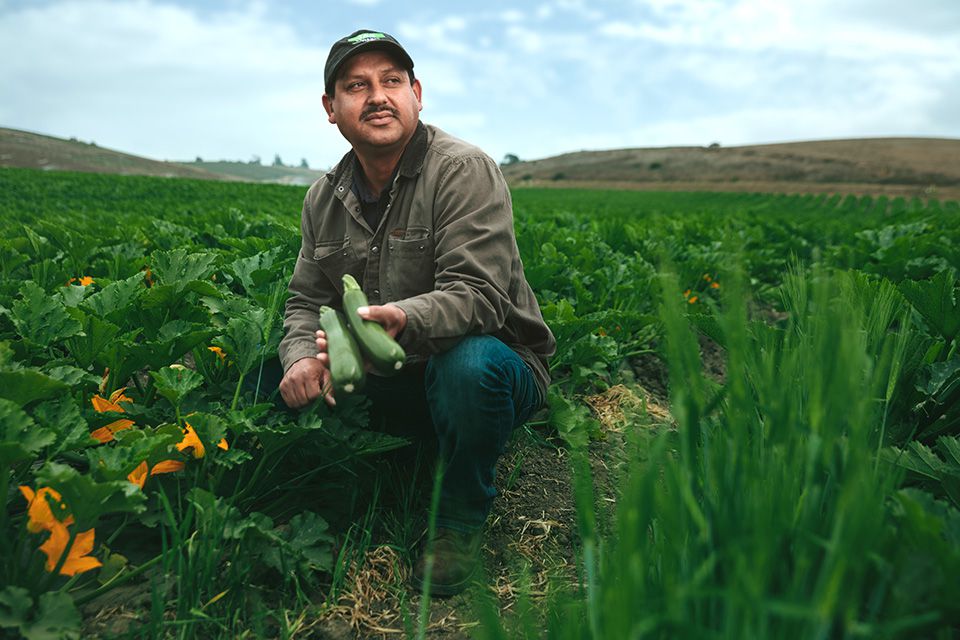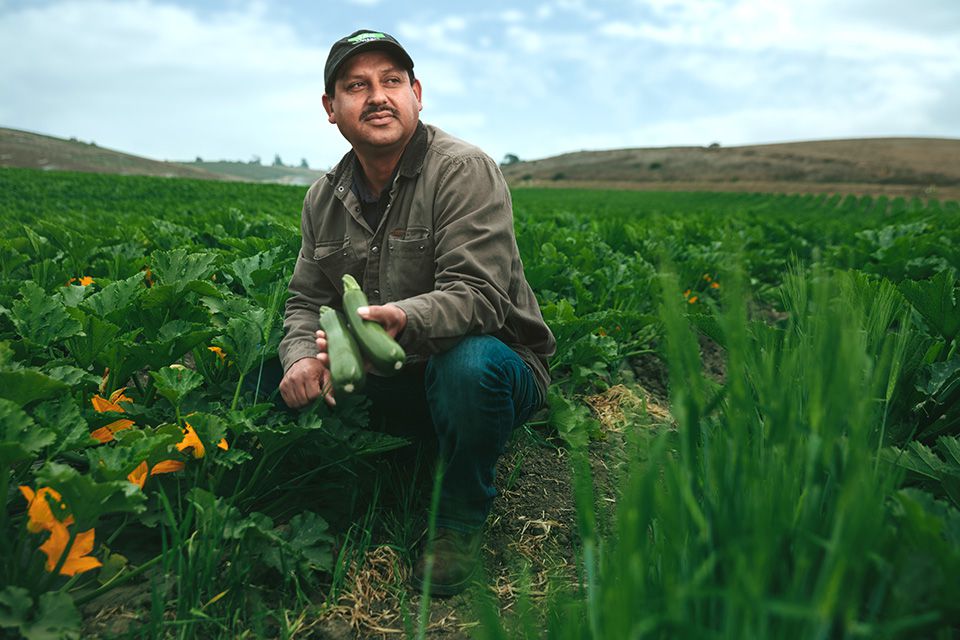A grim scene greeted me on the chilly, overcast morning final August when Tony Serrano took me to certainly one of his strawberry fields, not removed from Watsonville on the central California coast. It regarded like all the discipline had been devastated by illness or drought. Surveying his crop, Serrano shook his head. I could not inform whether or not he was embarrassed, depressed or just resigned. Leaves that had not already turned brown had been yellowing. His crops had been stunted and shriveled, the place there have been any surviving crops in any respect. Lengthy sections of farmland confirmed no indicators of something ever rising there-just naked plastic protecting the raised rows. Rotten, blackened fruits lay amongst invading weeds on the loamy soil.
What made the scene extra poignant was that earlier within the day I might visited certainly one of Serrano’s zucchini fields a half-hour’s drive south, outdoors of Salinas. It was immaculate. The crops had been vigorous, lined in blossoms and heavy with squash in all levels of ripeness. A dozen employees loaded wheelbarrow-like conveyances with good, deep inexperienced zucchini and rushed them by means of the rows to a ready field truck. Serrano himself appeared like a unique man: pleasant, humorous, often mischievous, with a smile that readily erupted from beneath his bushy mustache.
One factor defined the stark distinction between Serrano’s two fields: regardless of providing almost twice the going wages, he had been unable to safe sufficient employees to have a tendency and, when the time got here, decide his strawberries. The scarcity of labor had pressured him to carry out farming’s model of triage and abandon the berries to make sure that he may harvest as many zucchini as potential, which he’s contracted to promote to Costco. “Summer time squash are this farm’s bread and butter,” he defined. “I needed to give them first dibs on employees.”
“After I first began the farm, folks had been at all times exhibiting up on the gates begging for work,” Serrano stated. “Now, we farmers are those who’re begging for employees.” –Tony Serrano


Earlier than leaving the strawberry discipline, Serrano picked up one of many few edible berries in sight and urged me to take a chunk. Savoring one of many richest, most densely candy strawberries I might ever tasted, I used to be struck by the bitter irony it represented. Serrano had achieved the American dream. Smuggled illegally into the nation from Mexico at age 3 within the trunk of a Ford Gran Torino, Serrano joined his mother and father, who had arrived earlier, within the California fields. He turned a authorized resident in 1986 underneath President Reagan’s amnesty invoice, superior by means of a sequence of agricultural jobs and, 4 years in the past, fulfilled his dream of proudly owning his personal farm company-JAS Household Farms Natural. Along with strawberries and summer season squash, Serrano raises tomatoes, artichokes and cabbages on about 100 acres. However as an alternative of having fun with the success he labored so arduous to construct, he’s pressured to face by helplessly as his crops rot within the fields. 1000’s of {dollars}’ price of nutritious-and delicious-food was going to waste throughout us. “After I first began the farm, folks had been at all times exhibiting up on the gates begging for work,” Serrano stated. “Now, we farmers are those who’re begging for employees.”
A Rising Drawback
He’s removed from the one American farmer begging for assist. John Hollay is the senior director of presidency relations for the United Recent Produce Affiliation, a Washington, D.C., lobbying group that represents greater than 1,000 firms spanning all the spectrum of produce manufacturing and gross sales, from retail giants corresponding to Walmart and Kroger to small farmers like Serrano. Hollay informed me that the scarcity of labor was the “No. 1 situation” members talked about on the group’s annual conference final fall.
The shortage of employees started reducing into farmers’ earnings inside just a few years of the top of the current recession-costing them an estimated $1.3 billion in misplaced earnings in 2012, the final yr for which figures have been compiled. And Hollay insists the issue has grown worse since. “It is a disgrace,” he stated. “We’ve the crops however not sufficient employees to reap them. It must be a crime-the concept that we’d let this occur in a nation with our agricultural sources.” He personally feels that the difficulty goes past the companies he represents. “Meals insecurity is a nationwide safety menace. And that’s not one thing I say frivolously. A rustic that may’t present meals for its folks is solely not safe.”
In truth, the ramifications of the shortage of farmworkers are among the many few points business insiders and labor representatives agree on. “The scarcity is a really huge deal,” stated Erik Nicholson, the nationwide vice chairman of United Farm Staff, a California-based union group. “Earlier than, farmers may churn by means of people-‘You do not prefer it right here? Get out!’-and there have been 10 others ready for his or her job. Now, we’re going by means of a paradigm shift, transferring from a scenario the place land, water and labor had been ample to the place they’re turning into scarce.”
The disaster extends all over the place from the tomato fields of Florida to the apple orchards of Washington state. In 2011, in what turned out to be simply the vanguard of the labor crunch, undocumented migrant employees destined for Georgia averted the state as a result of they feared being expelled resulting from a brand new state legislation cracking down on unlawful immigrants. Farmers there misplaced $75 million because of having not having sufficient assist to reap their onions, melons, peaches and different produce. “All varieties of farms and ranches are going through labor shortages, however the issue is important within the fruit and vegetable sector the place farmers are extra depending on hand-harvesting,” stated Vincent “Zippy” Duvall, the president of the American Farm Bureau Federation, which represents 6 million farmers from all around the nation. Each single one of many nation’s 10 hottest fruits-including apples, desk grapes, strawberries and oranges-must be picked by hand. The identical applies to seven of the highest 10 greens we eat. (See “How Labor Shortages May Affect Your Plate” under) With out human harvesters, the vegetable sections of supermarkets would supply solely potatoes, carrots, leaf lettuce and salad combine. There can be no tomatoes, onions, head lettuce, bell peppers or cucumbers. And that is simply to call just a few.
Labor Scarcity Floor Zero
California is the nation’s largest farming state, with greater than $50 billion in annual agricultural gross sales. Wanting across the typical grocery store produce part, it’s troublesome to overstate the significance the state performs in supplying the nation with vegetables and fruit. It produces all the nation’s artichokes and plums, greater than 90 % of our broccoli, celery, avocados, tangerines, mandarins and nectarines, and almost 80 % of our cauliflower, apricots, strawberries, raspberries, grapes and lemons. All of those crops are hand-harvested. As well as, massive numbers of staff are required to function machines and work in packing homes.
Reliance on these laborers makes California central to at this time’s disaster. The overwhelming majority of the state’s farmworkers had been born in Mexico. And almost two-thirds of those-comprising half of California’s crop workers-are within the nation with out authorized documentation and subsequently weak to being deported, in accordance with Philip Martin, Ph.D., professor emeritus of agricultural and useful resource economics on the College of California, Davis. Twenty years in the past, the state was awash with farm labor because of the almost 100,000 unauthorized employees who got here into the nation every year. These newcomers, who tended to be younger, rootless and comfortable to relocate to fill job openings, as soon as made up almost 25 % of the agricultural workforce. At the moment, they account for lower than 2 %, having been changed by older, extra settled immigrants, who’ve been engaged on American farms a median of 15 years and are sometimes round 40 years old-an age the place many are not bodily capable of carry out strenuous, doubtlessly harmful jobs like climbing ladders with heavy containers to select fruit, or bending over broccoli or strawberry crops for hours in 90–degree warmth. Different farmworkers-whether immigrant or not-are leaving agriculture for higher-paying jobs in sectors corresponding to development and landscaping.
Creating what quantities to an ideal storm, many skilled laborers are additionally opting to maneuver again to Mexico. A research undertaken by the Pew Analysis Heart estimates that near 1 million Mexicans and their households left the USA and returned house between 2007 and 2016-causing the variety of Mexican immigrants residing in our nation to fall from a peak of 12.8 million to 12 million.


One farmworker, Oswaldo Cisneros Martinez, provided me a firsthand clarification of why lots of his compatriots are going again to their nations. He and I met simply previous sundown at a espresso store in Salinas after he had put in an extended day with a broccoli-picking crew. Martinez, who’s in his mid-30s, informed me by means of an interpreter that he knew a number of individuals who had returned to Mexico. Their causes had been primarily financial. “The pay is low in California,” he stated. “The rents are excessive. Two to 3 households live in the identical home. It’s getting inconceivable to reside right here now. Prior to now, it was higher.”
Knowledge on farmworkers’ salaries compiled by the U.S. Division of Commerce present that the typical annual earnings for all farmworkers is $17,400, however almost half make lower than $10,000. The common lease for a two–bedroom condominium in Salinas is $24,400 per yr.
“The ambiance can also be dangerous,” Martinez continued. “There’s plenty of anxiousness locally. Immigration brokers are invading folks’s houses utilizing the excuse that they’re searching for criminals. As soon as they even got here to an condominium I used to be residing in and arrested somebody. It issues us rather a lot. Particularly with the brand new president in Mexico, individuals are extra hopeful that situations will enhance there.” Most of all, although, he needs a bit of respect from American shoppers. “I wish to see that the general public values our work,” he stated. “We contribute to society, first by selecting the meals you eat, but additionally by spending cash on this nation on garments, gasoline, meals and lease like every other group of individuals.”
Struggling to Discover Options
In response to the disaster, some farmers have adopted what Martin calls the “4-S” methods: fulfill present employees to retain them with advantages and bonuses, stretch employees’ productiveness and enhance discipline situations by means of mechanical aids that make duties like harvesting quicker and fewer strenuous, substitute machines and robotics for employees when potential, and complement current employees with immigrants who’re right here on non permanent guest-worker visas.
Because the supervisor of Andrew & Williamson Recent Produce-a firm with about 1,000 staff and several other farms in California and Mexico that develop tomatoes, strawberries, raspberries, blackberries and cucumbers for a lot of nationwide super-market chains-Ernie Farley is implementing every of Martin’s 4-S steps. As I drove to fulfill him at a packinghouse close to Watsonville, I handed an enormous discipline edged with parked automobiles. A whole bunch of employees toiled elbow-to-elbow over rows of crops that prolonged so far as I may see. The lesson was clear: It takes plenty of human arms to reap our meals.
A receptionist on the packinghouse ushered me right into a convention room the place Farley greeted me from behind a laptop computer. With spherical rimless glasses and a grey goatee, Farley tasks a studious, nearly professorial picture befitting his college diploma in plant sciences. In some ways he’s Serrano’s reverse. However he’s coping with the identical workforce points, solely on a a lot bigger scale. “For the crops we develop, the scarcity of agricultural labor has been happening for a decade, and it is turning into the next and better topic of concern,” he stated.
Farley defined that his firm sometimes harvests strawberries on three-day rotations: “In case you have 90 acres, you will decide 30 on a Monday, 30 Tuesday, 30 Wednesday, then come again and repick the primary 30 acres on Thursday and so forth. Sunday is a time off. If you do not have sufficient employees to keep up that rotation, strawberries that had been alleged to be picked Monday get picked on Tuesday or Wednesday and finally you get thus far behind that the crop will get overripe and it’s a must to soar forward and abandon sections. That has been occurring to us typically.”
Andrew & Williamson is sufficiently big to have the ability to complement its labor power with authorized visitor employees. Below the legislation, employers should pay for these employees’ transportation to and from their house nations and supply them with permitted housing whereas they’re here-making them too costly for operations corresponding to Serrano’s that additionally haven’t got the sources to take care of the mandatory authorities purposes and different paperwork. In keeping with the United Recent Produce Affiliation, 42 % of growers do not use this system due to these causes. Even for individuals who can, bureaucratic snafus typically delay employees’ arrival, leading to crops not getting picked in time.
Farley and his enterprise companions are additionally using expertise to hurry up harvesting. Historically, a employee would decide a carton of berries after which lug it to a truck on the fringe of the sphere to be placed on a delivery pallet. The corporate has invested in machines that creep by means of fields on the similar tempo as its harvesting crews. The employees decide instantly behind the machines and easily put full containers on conveyor belts that carry them to the one that stacks them on the pallets. “We attempt to take into account each time labor is concerned,” -Farley stated. “Is utilizing a forklift extra environment friendly than hand-moving? Can we harvest at night time to maximise using our machines and maintain employees happy-when their way of life makes it higher for one partner to work at night time whereas the opposite takes care of the children? We’re additionally rising crops in buildings on counters which might be excessive sufficient that employees can decide standing up. General, we are able to now get the identical quantity harvested with a 3rd fewer employees.”
The holy grail for farmers going through a way forward for labor shortages is changing employees with robotics. Andrew & Williamson is on the forefront of that, as properly. For the previous 4 years, it has been conducting analysis on certainly one of its farms close to Ventura, in cooperation with Agrobot. “We have spent some huge cash on it, however we’re a great distance off from changing people,” Farley stated. “Keep in mind, we’re managing organic techniques with an nearly infinite variety of variables. Robotics have been profitable in companies the place you possibly can standardize procedures so the machines should make only a few choices. However with the crops we develop, these essential decisions-made by an individual at plant level-are extraordinarily troublesome to roboticize.”
Utilizing the instance of watermelon, he defined {that a} picker should first decide how ripe the fruit is. Then, if rain is within the forecast for the following few days, he would possibly determine to reap it instantly. If not, he could select to depart it to ripen a bit additional. All of this must be performed in a break up second. “Proper now, solely people can type all that out,” Farley stated.
Bigger growers have one different possibility, and it’ll displease the rising variety of conscientious customers preferring contemporary, domestically grown (or at the very least domestically grown) produce. American farm firms are more and more transferring their operations to nations corresponding to Mexico the place employees are ample. The Congressional Analysis Service reviews that previous to 2015, the U.S. exported extra agricultural merchandise to Mexico than it imported. However since then the pattern has reversed, largely due to a surge in Mexican produce being introduced into our nation. It is also one of many principal the reason why the California labor scarcity hasn’t but precipitated produce shortages and empty grocery store cabinets.
“American shoppers have a alternative. Would you like a system the place we import employees or import our meals?” –John Hollay, United Recent Produce Affiliation
“American shoppers have a alternative,” stated Hollay. “Would you like a system the place we import employees or import our meals?” His group is certainly one of 70 agricultural commerce associations that signed a letter to President Donald Trump in March 2017 pleading for him to offer “a lawful path for international employees to enter the USA on a nonimmigrant foundation.” Hollay defined that they are attempting to advertise a sensible answer that lies between the everlasting residence and path to citizenship championed by some politicians, and a system of no lawful protections by any means that others demand. “All we’re searching for is a few type of authorized standing for farmworkers. One thing that lets employers and employees to go house at night time and never fear about an ICE raid,” he stated.
That would come with authorized standing for employees already within the U.S., an improved visitor employee program, and no additional enforcement legal guidelines until they embody options to agriculture’s issues in attracting and sustaining a workforce. Able paper, Hollay’s affiliation writes: “The produce business doesn’t oppose correct enforcement of our nation’s immigration legal guidelines, however to take action with out addressing the truth that a lot of the workforce in agriculture is foreign-born can be devastating to our sector.”
I requested him whether or not, with at this time’s ambiance in Washington, there was any hope that Congress and the president would line up behind the type of reforms he needs. There was an extended pause earlier than he stated, “Stranger issues have occurred on this metropolis.”
How Labor Shortages May Affect Your Plate


Pictured recipe: Cobb Salad with Herb-Rubbed Rooster
Beneath are the ten hottest vegetables and fruit within the U.S. (ranked so as). Check out what number of of them depend on hand harvesting (*)-including each certainly one of our favourite fruits.
Fruits
1. Bananas*
2. Apples*
3. Desk grapes*
4. Strawberries*
5. Oranges*
6. Watermelon*
7. Lemons*
8. Blueberries*
9. Peaches*
10. Cantaloupe*
Greens
1. Potatoes
2. Tomatoes*
3. Onions*
4. Carrots
5. Heads of lettuce*
6. Broccoli*
7. Combined salad greens
8. Bell peppers*
9. Celery*
10. Cucumbers*
BARRY ESTABROOK is a three-time James Beard Award–successful journalist. An up to date version of his exposé, Tomatoland, was launched final yr.

